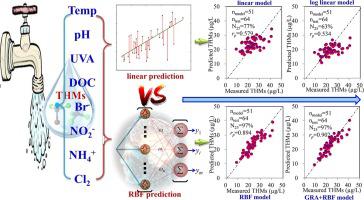当前位置:
X-MOL 学术
›
J. Hydrol.
›
论文详情
Our official English website, www.x-mol.net, welcomes your
feedback! (Note: you will need to create a separate account there.)
Radial basis function artificial neural network (RBF ANN) as well as the hybrid method of RBF ANN and grey relational analysis able to well predict trihalomethanes levels in tap water
Journal of Hydrology ( IF 5.9 ) Pub Date : 2020-12-01 , DOI: 10.1016/j.jhydrol.2020.125574 Huachang Hong , Zhiying Zhang , Aidi Guo , Liguo Shen , Hongjie Sun , Yan Liang , Fuyong Wu , Hongjun Lin
Journal of Hydrology ( IF 5.9 ) Pub Date : 2020-12-01 , DOI: 10.1016/j.jhydrol.2020.125574 Huachang Hong , Zhiying Zhang , Aidi Guo , Liguo Shen , Hongjie Sun , Yan Liang , Fuyong Wu , Hongjun Lin

|
Abstract Many models have been developed in previous studies for predicting the formation of disinfection by-products (DBPs) in drinking water. However, most of them were linear or log-linear regression models, and generated based on simulated disinfection of source water or treated water in a laboratory other than real tap water, which shows low application potential in practice. In this study, a radial basis function artificial neural network (RBF ANN) as well as the hybrid method of RBF ANN and grey relational analysis (GRA) was proposed to predict trihalomethanes (THMs) levels in real distribution systems. A total of 64 sets of data including THMs levels (trichloromethane (TCM), bromodichloromethane (BDCM) and total-THMs (T-THMs)) and 8 water quality parameters (temperature, pH, UV absorbance at 254 (UVA254), dissolved organic carbon, bromide, residual free chlorine, nitrite and ammonia) were used to train and verify the proposed model. As compared to linear and log-linear regression models (rp = 0.254–0.659; N25 = 46–78%), RBF ANNs for THMs (TCM, BDCM and T-THMs) prediction consistently show higher regression coefficients (rp = 0.760–0.925) and prediction accuracy (N25 = 92–98%), which indicates the high capability of RBF ANN to learn the complex non-linear relationships involved THMs formation. Further analysis shows that RBF ANNs using fewer water quality parameters based on GRA still make excellent performance in THMs prediction (rp = 0.760–0.946; N25 = 92–98%). This result demonstrates that GRA can be an effective technique to facilitate the generation of sound RBF ANN models with fewer factors.
中文翻译:

径向基函数人工神经网络 (RBF ANN) 以及 RBF ANN 和灰色关联分析的混合方法能够很好地预测自来水中的三卤甲烷含量
摘要 在先前的研究中已经开发了许多模型来预测饮用水中消毒副产物 (DBP) 的形成。然而,它们大多是线性或对数线性回归模型,是基于对源水或实验室处理水的模拟消毒而生成的,而不是真实的自来水,在实践中应用潜力不大。在这项研究中,提出了径向基函数人工神经网络 (RBF ANN) 以及 RBF ANN 和灰色关联分析 (GRA) 的混合方法来预测实际配电系统中的三卤甲烷 (THM) 水平。总共64组数据,包括THMs水平(三氯甲烷(TCM)、溴二氯甲烷(BDCM)和总THMs(T-THMs))和8个水质参数(温度、pH值、254处的紫外吸光度(UVA254)、溶解有机物碳、溴、残留游离氯、亚硝酸盐和氨)被用来训练和验证所提出的模型。与线性和对数线性回归模型(rp = 0.254–0.659;N25 = 46–78%)相比,用于 THM(TCM、BDCM 和 T-THM)预测的 RBF ANN 始终显示更高的回归系数(rp = 0.760–0.925 ) 和预测准确度 (N25 = 92–98%),这表明 RBF ANN 在学习涉及 THM 形成的复杂非线性关系方面具有很高的能力。进一步的分析表明,基于 GRA 使用较少水质参数的 RBF ANN 在 THM 预测中仍然表现出色(rp = 0.760–0.946;N25 = 92–98%)。该结果表明 GRA 可以是一种有效的技术,以促进具有较少因素的健全 RBF ANN 模型的生成。亚硝酸盐和氨)被用来训练和验证所提出的模型。与线性和对数线性回归模型(rp = 0.254–0.659;N25 = 46–78%)相比,用于 THM(TCM、BDCM 和 T-THM)预测的 RBF ANN 始终显示更高的回归系数(rp = 0.760–0.925 ) 和预测准确度 (N25 = 92–98%),这表明 RBF ANN 在学习涉及 THM 形成的复杂非线性关系方面具有很高的能力。进一步的分析表明,基于 GRA 使用较少水质参数的 RBF ANN 在 THM 预测中仍然表现出色(rp = 0.760–0.946;N25 = 92–98%)。该结果表明,GRA 可以是一种有效的技术,以促进具有较少因素的健全 RBF ANN 模型的生成。亚硝酸盐和氨)被用来训练和验证所提出的模型。与线性和对数线性回归模型(rp = 0.254–0.659;N25 = 46–78%)相比,用于 THM(TCM、BDCM 和 T-THM)预测的 RBF ANN 始终显示更高的回归系数(rp = 0.760–0.925 ) 和预测准确度 (N25 = 92–98%),这表明 RBF ANN 在学习涉及 THM 形成的复杂非线性关系方面具有很高的能力。进一步的分析表明,基于 GRA 使用较少水质参数的 RBF ANN 在 THM 预测中仍然表现出色(rp = 0.760–0.946;N25 = 92–98%)。该结果表明,GRA 可以是一种有效的技术,以促进具有较少因素的健全 RBF ANN 模型的生成。用于 THM(TCM、BDCM 和 T-THM)预测的 RBF ANN 始终显示更高的回归系数(rp = 0.760–0.925)和预测准确度(N25 = 92–98%),这表明 RBF ANN 学习复杂的能力非线性关系涉及 THMs 的形成。进一步的分析表明,基于 GRA 使用较少水质参数的 RBF ANN 在 THM 预测中仍然表现出色(rp = 0.760–0.946;N25 = 92–98%)。该结果表明 GRA 可以是一种有效的技术,以促进具有较少因素的健全 RBF ANN 模型的生成。用于 THM(TCM、BDCM 和 T-THM)预测的 RBF ANN 始终显示更高的回归系数(rp = 0.760–0.925)和预测精度(N25 = 92–98%),这表明 RBF ANN 学习复杂的能力非线性关系涉及 THMs 的形成。进一步的分析表明,基于 GRA 使用较少水质参数的 RBF ANN 在 THM 预测中仍然表现出色(rp = 0.760–0.946;N25 = 92–98%)。该结果表明 GRA 可以是一种有效的技术,以促进具有较少因素的健全 RBF ANN 模型的生成。进一步的分析表明,基于 GRA 使用较少水质参数的 RBF ANN 在 THM 预测中仍然表现出色(rp = 0.760–0.946;N25 = 92–98%)。该结果表明,GRA 可以是一种有效的技术,以促进具有较少因素的健全 RBF ANN 模型的生成。进一步的分析表明,基于 GRA 使用较少水质参数的 RBF ANN 在 THM 预测中仍然表现出色(rp = 0.760–0.946;N25 = 92–98%)。该结果表明 GRA 可以是一种有效的技术,以促进具有较少因素的健全 RBF ANN 模型的生成。
更新日期:2020-12-01
中文翻译:

径向基函数人工神经网络 (RBF ANN) 以及 RBF ANN 和灰色关联分析的混合方法能够很好地预测自来水中的三卤甲烷含量
摘要 在先前的研究中已经开发了许多模型来预测饮用水中消毒副产物 (DBP) 的形成。然而,它们大多是线性或对数线性回归模型,是基于对源水或实验室处理水的模拟消毒而生成的,而不是真实的自来水,在实践中应用潜力不大。在这项研究中,提出了径向基函数人工神经网络 (RBF ANN) 以及 RBF ANN 和灰色关联分析 (GRA) 的混合方法来预测实际配电系统中的三卤甲烷 (THM) 水平。总共64组数据,包括THMs水平(三氯甲烷(TCM)、溴二氯甲烷(BDCM)和总THMs(T-THMs))和8个水质参数(温度、pH值、254处的紫外吸光度(UVA254)、溶解有机物碳、溴、残留游离氯、亚硝酸盐和氨)被用来训练和验证所提出的模型。与线性和对数线性回归模型(rp = 0.254–0.659;N25 = 46–78%)相比,用于 THM(TCM、BDCM 和 T-THM)预测的 RBF ANN 始终显示更高的回归系数(rp = 0.760–0.925 ) 和预测准确度 (N25 = 92–98%),这表明 RBF ANN 在学习涉及 THM 形成的复杂非线性关系方面具有很高的能力。进一步的分析表明,基于 GRA 使用较少水质参数的 RBF ANN 在 THM 预测中仍然表现出色(rp = 0.760–0.946;N25 = 92–98%)。该结果表明 GRA 可以是一种有效的技术,以促进具有较少因素的健全 RBF ANN 模型的生成。亚硝酸盐和氨)被用来训练和验证所提出的模型。与线性和对数线性回归模型(rp = 0.254–0.659;N25 = 46–78%)相比,用于 THM(TCM、BDCM 和 T-THM)预测的 RBF ANN 始终显示更高的回归系数(rp = 0.760–0.925 ) 和预测准确度 (N25 = 92–98%),这表明 RBF ANN 在学习涉及 THM 形成的复杂非线性关系方面具有很高的能力。进一步的分析表明,基于 GRA 使用较少水质参数的 RBF ANN 在 THM 预测中仍然表现出色(rp = 0.760–0.946;N25 = 92–98%)。该结果表明,GRA 可以是一种有效的技术,以促进具有较少因素的健全 RBF ANN 模型的生成。亚硝酸盐和氨)被用来训练和验证所提出的模型。与线性和对数线性回归模型(rp = 0.254–0.659;N25 = 46–78%)相比,用于 THM(TCM、BDCM 和 T-THM)预测的 RBF ANN 始终显示更高的回归系数(rp = 0.760–0.925 ) 和预测准确度 (N25 = 92–98%),这表明 RBF ANN 在学习涉及 THM 形成的复杂非线性关系方面具有很高的能力。进一步的分析表明,基于 GRA 使用较少水质参数的 RBF ANN 在 THM 预测中仍然表现出色(rp = 0.760–0.946;N25 = 92–98%)。该结果表明,GRA 可以是一种有效的技术,以促进具有较少因素的健全 RBF ANN 模型的生成。用于 THM(TCM、BDCM 和 T-THM)预测的 RBF ANN 始终显示更高的回归系数(rp = 0.760–0.925)和预测准确度(N25 = 92–98%),这表明 RBF ANN 学习复杂的能力非线性关系涉及 THMs 的形成。进一步的分析表明,基于 GRA 使用较少水质参数的 RBF ANN 在 THM 预测中仍然表现出色(rp = 0.760–0.946;N25 = 92–98%)。该结果表明 GRA 可以是一种有效的技术,以促进具有较少因素的健全 RBF ANN 模型的生成。用于 THM(TCM、BDCM 和 T-THM)预测的 RBF ANN 始终显示更高的回归系数(rp = 0.760–0.925)和预测精度(N25 = 92–98%),这表明 RBF ANN 学习复杂的能力非线性关系涉及 THMs 的形成。进一步的分析表明,基于 GRA 使用较少水质参数的 RBF ANN 在 THM 预测中仍然表现出色(rp = 0.760–0.946;N25 = 92–98%)。该结果表明 GRA 可以是一种有效的技术,以促进具有较少因素的健全 RBF ANN 模型的生成。进一步的分析表明,基于 GRA 使用较少水质参数的 RBF ANN 在 THM 预测中仍然表现出色(rp = 0.760–0.946;N25 = 92–98%)。该结果表明,GRA 可以是一种有效的技术,以促进具有较少因素的健全 RBF ANN 模型的生成。进一步的分析表明,基于 GRA 使用较少水质参数的 RBF ANN 在 THM 预测中仍然表现出色(rp = 0.760–0.946;N25 = 92–98%)。该结果表明 GRA 可以是一种有效的技术,以促进具有较少因素的健全 RBF ANN 模型的生成。











































 京公网安备 11010802027423号
京公网安备 11010802027423号